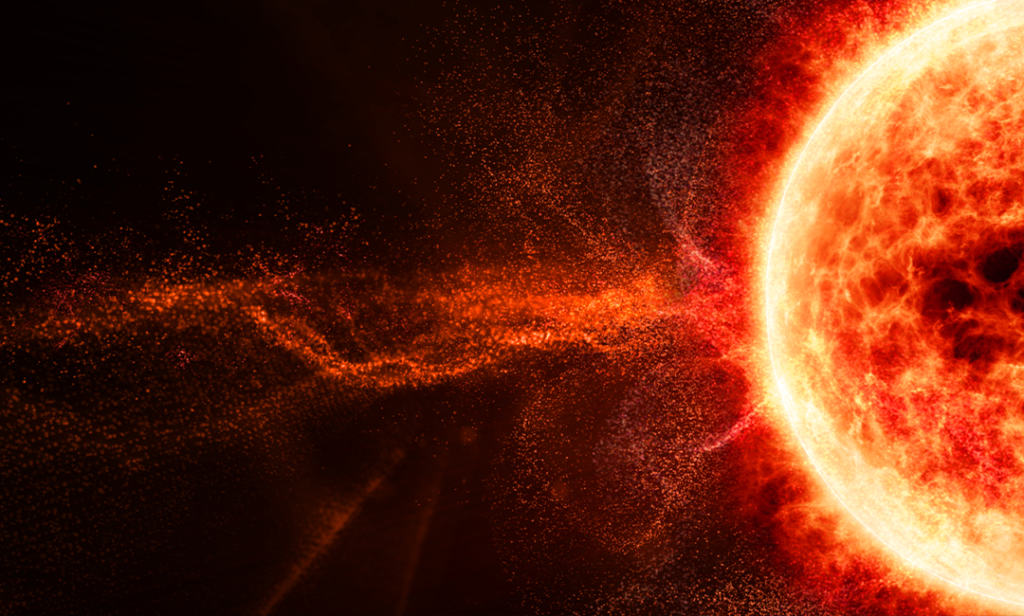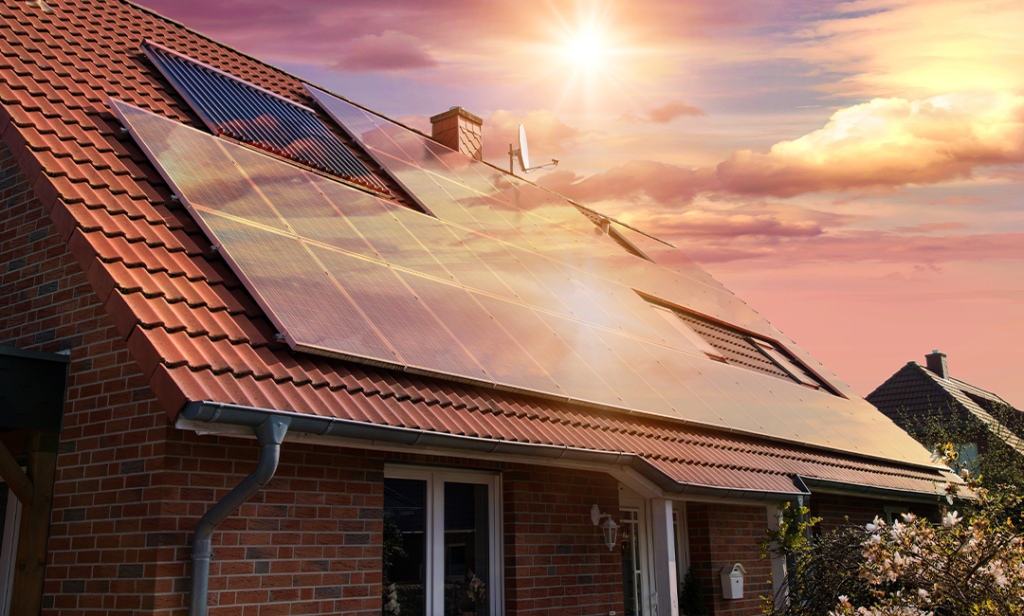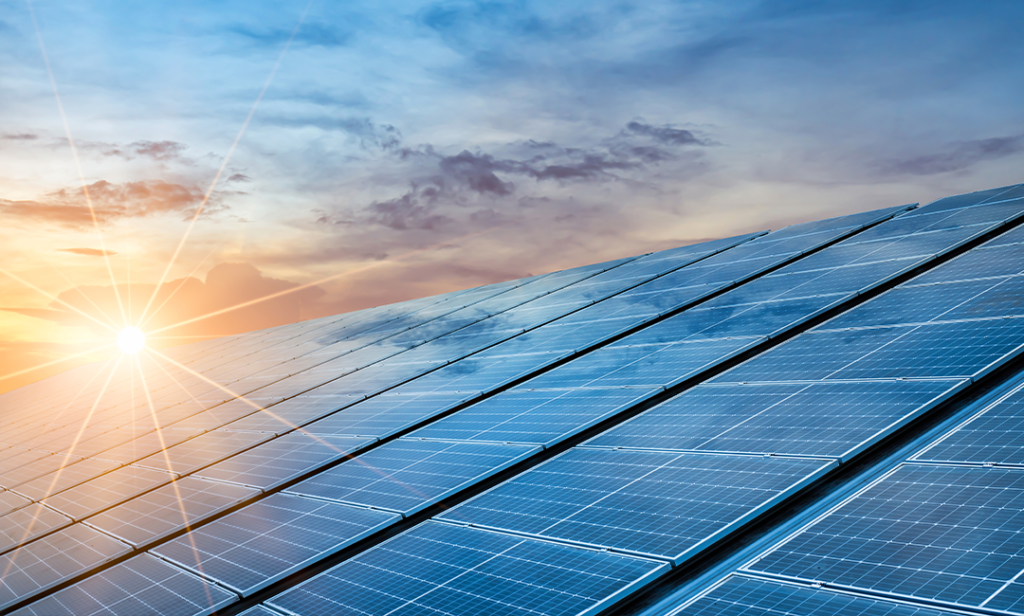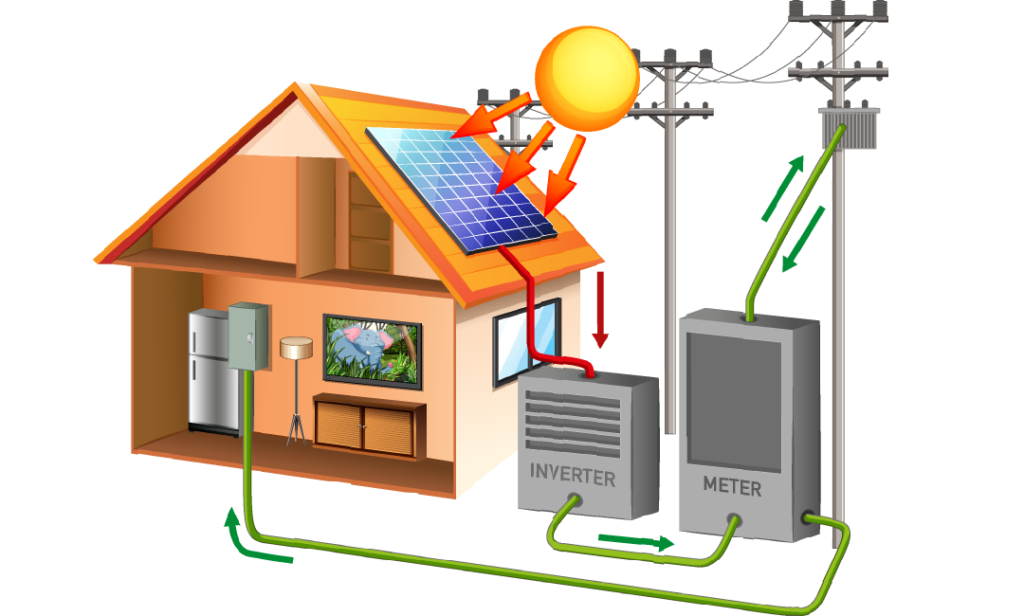Solar energy is energy that’s created in the sun. Because solar energy is coming directly to us on Earth from the sun, it’s the most plentiful, and essentially endless, source of energy out there. Solar energy is clean, renewable, and can take on many forms when it comes to providing us power.
The Creation of Solar Energy
The sun creates and releases solar energy. But how does it do this? A massively powerful process called nuclear fusion is occurring constantly in the sun.
Nuclear Fusion
The process of fusion takes place in the core of the sun, and is the result of hydrogen atoms violently colliding. After they collide with one another, the hydrogen atoms fuse, creating helium atoms. The final result of this nuclear fusion in the sun is solar energy.

Proton-Proton Chain Reaction
The nuclear fusion going inside the sun’s core is also known as a process called the proton-proton chain reaction (PP reaction). This is because in this case, the protons are the main players, and they’re the same/interchangeable as/with hydrogen atoms. When nuclear fusion is the result of PP, unbelievable amounts of energy are released from the sun and travel to the earth in the form of particles and waves.
This is the solar energy that we’re familiar with because it’s the energy that helps to sustain all life on Earth, as well as the energy that causes heat, wind, and various weather patterns.
Electromagnetic Radiation (EMR)
All of this solar energy leaving the sun and traveling to Earth comes in the form of Electromagnetic Radiation (EMR). EMR shows up as waves, or wavelengths. We recognize these as UV, or ultraviolet waves, gamma rays, X-rays, and infrared radiation.

Infrared Radiation
Infrared radiation is an important one because this is the kind of electromagnetic wave, or radiation, released from the sun that causes heat. Though human eyes can’t technically see solar radiation, we can certainly feel the heat from the sun.
What is Solar Energy Responsible For?
Solar energy is responsible for pretty much all of life on Earth. We’ll cover some of the bigger things here briefly.
The Greenhouse Effect
Solar energy is vital in sustaining life on earth. The radiation released by the sun that travels to Earth won’t all be absorbed. So the radiation, or energy, that’s not absorbed is sent back into the atmosphere. This in turn creates a warming effect called the greenhouse effect.
While we often hear about the greenhouse effect as something negative, the greenhouse effect is actually the process that lets life live and thrive on earth. Most living things can’t thrive, function, and much less reproduce if things are too cold (or, conversely, too hot).
Photosynthesis
Photosynthesis is the process through which plants create food and grow. Plants aren’t creating food so that they can then eat each other. But the solar energy they’re absorbing is taken in through a complex process called photosynthesis that allows the plants to feed themselves.
Without photosynthesis, plants wouldn’t grow, reproduce, or be able to feed other organisms, the biggest of which being animals and humans.
Producers or Autotrophs
We mentioned how important solar energy is to plants. Another way of referring to these plants, fungi, etc., is to call them “producers” or “autotrophs”. Since producers are basically the foundational organisms of the food chain, life wouldn’t exist without them. This is how vital solar energy is.
What Happens When Autotrophs Decay?
Everything on Earth has a life cycle, though the length of each depends on the particular organism.
Autotrophs are thought to have originally been water plants. Obviously these plants evolved to not only be aquatic, but also dry-land dwellers as well.
When autotrophs die, they eventually break down and get broken down into the soil. This process repeats for millennia. You can imagine that any process like this will build up layers of matter in varying stages of decay. These layers eventually go further and further into the Earth.
Creation of Fossil Fuels
As the autotrophs, or plant matter, decay and go further into the Earth, the material is exposed to extreme pressure and temperatures. The combination of high pressure and temperature end up causing these materials to turn into what we know as fossil fuels.
The most common fossil fuels are natural gas, coal, and petroleum. Humans have used these as energy sources for decades.
The Problem With Fossil Fuels
While humans have used fossil fuels for decades as a source of energy, they’re problematic. Fossil fuels are fairly easily accessed and then used. However, they’re extremely dirty and end up being huge pollutants. They’re also not renewable because when they’re removed from the Earth, there’s no way to instantly replace them.
Solar Energy is Renewable and Versatile
Solar energy is renewable, simply because of the fact that it’s the energy given off by the sun. The sun is constantly creating energy and releasing it, 24/7, 365 days a year. The uses for solar energy are pretty vast, and the only difficulty we confront as humans is how to capture, or harness, that energy.

What Can We Do With Solar Power and Energy?
Solar energy’s uses are vast. Not only does solar radiation give life to everything on Earth, it can also be harnessed by humans and used to power our homes, cars, and anything else needing energy/electricity.
So How Is Solar Energy Collected?
There are a few different ways we can collect solar energy and turn it into a usable form. The two main ways that we can take solar radiation and make it usable are through photovoltaics (which is part of the process that makes solar panels work), and something called solar thermal collectors, or capture.
Photovoltaics
Simply put, photovoltaics, or the photovoltaic effect, is the process through which solar radiation is captured and turned directly into useable energy. The most recognizable way the photovoltaic effect is applied is through the use of solar panels.
An interesting fact about photovoltaics is that one of the first places we saw it used was on various spacecrafts (spaceships and other space-going vehicles), as well as on the International Space Station.
What Solar Projects Use Photovoltaics?
Although photovoltaics certainly aren’t limited to only small scale solar energy projects, as is obvious knowing that it’s widely used in space stations, spacecrafts, etc., this is where we will most commonly see them used.
This is because it’s generally easier to install solar panels on the roof of a home or smaller business than it is on some massive energy plant, as an example. However, there are photovoltaic power stations installed all over the world that are used to supply electricity on a huge scale.

Solar Panels
Alright, so we know that solar panels are the main way of using the photovoltaic effect to our (humans’) benefit, but how exactly do solar panels work? We’ll go into some basics here in this article, but check out our other full-length blog article on how solar panels work!
Solar Cells Convert Solar Energy Inside Solar Panels
First, it’s important to know that solar panels are made up of millions of solar cells. But what do the solar cells do?
The solar cells are the units that are actually responsible for collecting the solar radiation, or energy, storing that energy, and then turning it into an electrical current. This the photovoltaic effect in action.
The electrical current produced by the solar cells inside the solar panels is what we can then use in all of the electricity-requiring appliances in our homes.
Solar Cell Makeup
The inner workings and makeup of solar cells are super important to their function and to the production of useable solar energy.
Semiconductors
Inside each solar cell is a silicon semiconductor. When the solar radiation (energy) hits the solar cell and then the semiconductor, electrons are shaken loose. As the electrons start moving around, this is creating an electrical current called a DC, or direct current.
Solar Inverters
That DC current that was created when the electrons got shaken loose isn’t a useable form of energy or electricity. So something has to convert that DC energy to AC energy, or an alternating current. This is essential because in the U.S., our electric grid runs on AC energy as opposed to DC. So if the solar inverters didn’t make this conversion, we would have a lot of unusable energy floating around.

Homeowners and Solar Energy
The most common type of solar energy system that we see in homes today is a photovoltaic (or PV) solar energy system. In a PV solar energy system, there are some number of solar panels installed on the rooftop of the home.
It’s up to the homeowner how grid-reliant they want to be. What this means is that when you’ve made the decision to go solar, you can still use the electric grid in addition to your solar panels. You can also go completely off-grid.
Either decision, staying grid-tied or going totally off-grid, is a good one. When you decide to use solar energy to help power your home, you’re going to an energy solution that’s renewable and way cleaner than any other energy form out there.
What Can Solar Energy Do For You?
Besides solar energy being clean and renewable, it’s actually a much cheaper form of energy in the long term. While the initial purchase and installation price of a solar energy system can be hefty, it does save you money over time.

Lowers or Eliminates Your Electric Bill
Using solar power can significantly lower your monthly electric bill, even if you choose to remain grid-tied. This is the result of your using far less electricity generated by the power grid, and relying instead on the electricity provided by your solar panels.
If you choose to go completely off-grid and solar powered, this means that your electric bill will be eliminated because you’re relying only on your solar energy system. One way you’re able to do this is through the use of solar battery backups. This allows you to store the excess energy your solar panels produce so that you can use it at night and at other times when your solar panels aren’t able to produce electricity.
Solar Thermal Energy
Solar thermal energy is another way in which humans can make use of the energy given off by the sun. With solar thermal energy, it’s actually the heat given off by the sun that we’re capturing and using.
Solar Thermal Collectors
Solar thermal collectors, or solar thermal capture, are important to mention because while you won’t be using them on your home, they play a big role in the success of the solar energy world.
Solar thermal capture is used when electricity needs to be produced on enormous scales. An instance you’d see this type of solar energy capture/production is in a massive power plant, or something similar.
Where Would I See Solar Thermal Energy Used?
Solar thermal energy can be used in a lot more ways than in a PV system. While solar thermal energy is great in certain, smaller scale situations, it’s not a very efficient way to collect and create electricity on a small scale.
However, solar thermal energy is used for more than just the generation of electricity via solar energy. There are some ways you can use solar thermal energy to benefit your personal home or business.
Different Types of Solar Thermal Energy
When we’re talking about solar thermal energy, we mentioned already that solar thermal collectors are responsible for taking the heat from the solar radiation and converting it into different forms that can be used.
To follow, there are three different types of solar thermal energy. Here’s a quick rundown of them, since we think solar thermal energy is important to add to the discussion when we’re talking about clean, renewable, planet-healthy forms of energy.
*Note that the first two forms of solar thermal energy can be used for small-scale and residential settings, and the third form is generally for much larger-scale buildings and settings.
Low-Temperature Solar Thermal Energy
Low temperature solar thermal energy is used for cooling and heating. But cooling and heating what? Air. Think about this form of solar energy as air conditioning or heat. That’s a really simplified way to present it.
But low temperature solar thermal energy is a form of passive solar energy use. This comes into play in various buildings that are specifically designed for passive heating or cooling. Take, for example, a straw bale building. Some rooms will allow a lot of light, or rays from the sun, to enter. This means that this room will be warmer because the solar radiation is passively collected and used to heat that space.
If you want a room to be cooler, then it would follow that you would have that room designed in way that would block the sun’s rays.
Mid-Temperature Solar Thermal Energy
Mid-temperature solar thermal energy is used when you’re wanting solar energy to be able to heat water. You would see something like this in a solar hot water system. In a system like this, you’d have collectors on your roof that capture the sun’s heat.
This is an interesting setup, because once the sun’s heat is collected, it’s quickly transferred to your water pipes where it comes in contact with the cool water and warms it up. This method of heating water effectively eliminates your reliance on gas, electricity, coal, etc. as ways to heat the water used in your home.
High-Temperature Solar Thermal Energy
This is the type of solar thermal energy that we see used on enormous scales. Another name for high-temperature solar thermal energy is concentrated solar power. This is the type that generates electricity. High-temperature solar energy is actually used in solar thermal electricity plants, so you can imagine the size of those operations!
Instead of solar panels or other means of capturing the solar energy/radiation, mirrors are used in solar thermal energy plants. These mirrors capture (absorb, reflect, etc.) the sun’s rays/energy and focus them onto tubes. Inside the tubes is a liquid that’s capable of holding and containing the sun’s heat energy.
The next step in a high-temperature solar thermal energy setup is that the now-hot liquid turns the water into steam. This steam isn’t your everyday steam. It’s hot enough, and there’s enough of it, that it can generate electricity by powering turbines.
FAQ’s About Solar Energy and Power
It’s impossible to summarize all the in’s and outs of solar energy and power in a short article. The topic is huge, but at Convert Solar, we always try to educate our customers and provide as much information as possible.
So here are some of the most commonly asked questions we get when people are first thinking about solar energy and installing a solar energy system.
How Does Solar Energy Actually Work?
In order for solar energy to work and to be useful to humans, we have to capture it somehow.
When you have solar panels installed on your home’s rooftop, the generation of solar power starts the second the sun’s rays hit the solar panels. The solar cells, or photovoltaic cells, in the panels then absorb those light particles (in the form of photons). This creates a DC current.
Solar inverters take that DC current and change it to a useable, or AC current. The energy from the AC current goes to the electrical panel on your house and is then sent throughout the house to where it’s needed.
What Are Some of the Main Uses for Solar Power?
There are two primary ways in which solar power can be used. The first is to create and generate electricity. This is with solar panels that you install on your roof. The second way is to generate solar thermal energy. This would be with the solar power plants, or concentrated solar power.
Since most of our customers are everyday people, they’re more focused on rooftop solar energy systems that take the sun’s energy and turn it into a useful form of electricity. This is such a great use of solar power because it’s clean and renewable, and can save you huge amounts of money!
Does Solar Work On Cloudy Days?
Yes! Solar power works even if it’s cloudy. This is because the sun still gives off radiation, regardless of the amount of clouds in the sky. Your rooftop solar panels are able to absorb this radiation, though the amounts absorbed, and therefore the amounts of power given off, will vary. Check out this article on solar power and cloudy days for a ton of great information!
What Lifespan Can I Expect from My Solar Panels?
The typical lifespan for rooftop solar panels is in the neighborhood of 25-30 years. Throughout solar panels’ life, you’ll see a slow decline in their productivity, but nothing alarming and nothing that actually affects your home’s energy use.
After the 25-30 year mark, it’s normal to see a sharper decline in your solar panels’ productivity, but still, considering that lifespan, solar panels are more than worth it. You’ll have installed something for your house that generates free, clean energy straight from the sun!
Solar is the way of the future, and at Convert Solar, we’re here to help you make the decision to go ahead with this awesome form of clean, renewable, and cheap energy! Contact us today and we’ll help guide you through the process of finding the right solar panels and the right installer for your home solar energy system!


